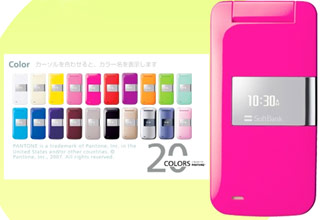SoftBank Mobile Announces New 3G Phones
 SoftBank Mobile rounded out the Japanese operators spring handset announcement rush this week by announcing a new fleet of models – Flash site Here – with major bling factor. According to the companies announcement most models will be available by March which is traditionally the busiest handset replacement month of the year in Japan as the new academic and fiscal year begins on April 1st. Masayoshi Son did his best Steve Jobs impersonation, black turtle-neck and all, however there was no announcement related to the recent news from MacWorld.
SoftBank Mobile rounded out the Japanese operators spring handset announcement rush this week by announcing a new fleet of models – Flash site Here – with major bling factor. According to the companies announcement most models will be available by March which is traditionally the busiest handset replacement month of the year in Japan as the new academic and fiscal year begins on April 1st. Masayoshi Son did his best Steve Jobs impersonation, black turtle-neck and all, however there was no announcement related to the recent news from MacWorld.
Models of interest include the 911T by Toshiba, a candybar slider with a huge 3-inch screen running on high speed HSDPA has a 3.2-megapixel camera, 1GB of internal memory, 1Seg digital tv, it’s FeliCa m-commerce enabled and comes complete with a pair of Oakley Thumps which connect via bluetooth. Other new handset highlights include; the 812SH Pantone series by Sharp (pictured right) with 20 different colors to choose from, the 812T Kodomobile model designed especially for children and Nokia’s E-61 Communicator – labeled as X01NK – which has Japanese Kanji text input and comes Wi-Fi enabled.
There are three new phones from Samsung including the 708SC slider which claims the title for the worlds thinnest 3G handset at a mere 8.4mm thick and the 707SC Swarovski Crystal version which is a follow-up to the earlier 705SH model [.jpg image] which sold-out the day it was launched last fall.
There have been over 30 new handset models announced by the three main operators during the last week for content and application developers, industry wags and ultimately the marketplace at large to chew over.. whew! WWJ subscribers login for more comments, photos and a video-link to watch the actual presentation (70 minute runtime) from the press conference held in Shinagawa on Thursday.


 DoCoMo today announced the development of new 3G FOMA handsets – the 703i-series plus the D800iDS and SO903iTV. The 703i-series consists of eight models: N703i, P703i, D703i, F703i, N703iD, P703i, SH703i and SO703i. Most of the models are extra slim, with the N703i (image at right) and P703i being the thinnest 3G clamshell handsets in the world, at 11.4mm each, as of 15 January 2007 (and according to the company).
DoCoMo today announced the development of new 3G FOMA handsets – the 703i-series plus the D800iDS and SO903iTV. The 703i-series consists of eight models: N703i, P703i, D703i, F703i, N703iD, P703i, SH703i and SO703i. Most of the models are extra slim, with the N703i (image at right) and P703i being the thinnest 3G clamshell handsets in the world, at 11.4mm each, as of 15 January 2007 (and according to the company). A recent
A recent